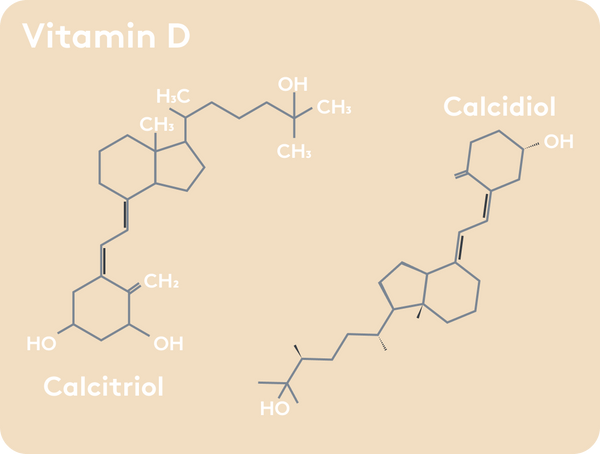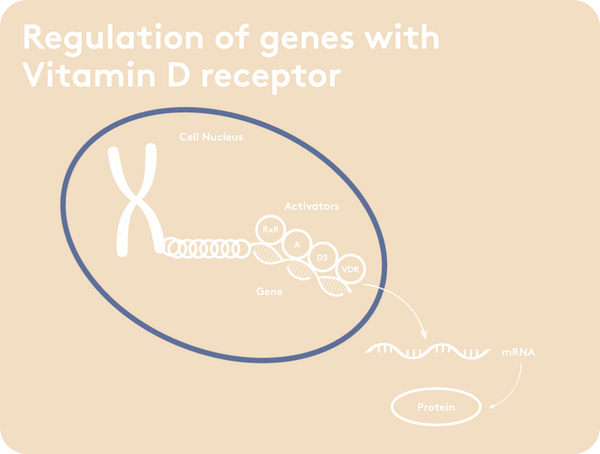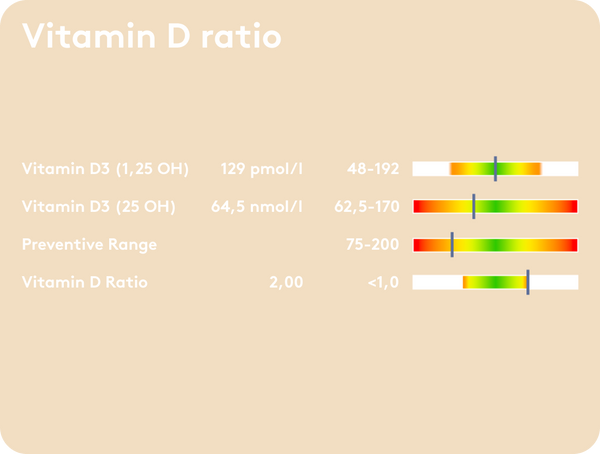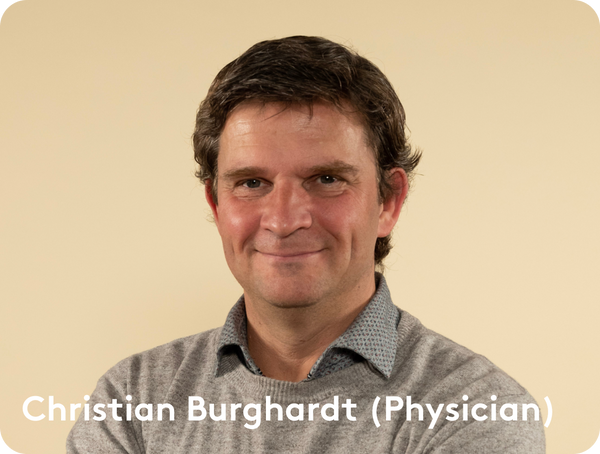Introduction
Do you know how vitamin D regulates your immune system?
"Vitamin D deficiency is not as rare as you might think. I test the vitamin D level of every patient who comes to my practice. My motto is "measure, do, measure".
- Christian Burghardt
About 60 % of all adults in Germany have a vitamin D deficiency or are insufficiently supplied with it [1]. The rate is estimated to be higher for older people. But does a lot of vitamin D also help a lot?
In this article we will tell you about the special immune vitamin D. What is it exactly, what can it do, and how can you make vitamin D work for you?
- Christian Burghardt
About 60 % of all adults in Germany have a vitamin D deficiency or are insufficiently supplied with it [1]. The rate is estimated to be higher for older people. But does a lot of vitamin D also help a lot?
In this article we will tell you about the special immune vitamin D. What is it exactly, what can it do, and how can you make vitamin D work for you?
Wissen für deine Ohren!
Keine Zeit zum Lesen? Hier findest du Claires Artikel zum Anhören.
Table of Contents
• What is vitamin D anyway?
• What are important functions of vitamin D in the body?
• Why are sunlight and food alone not enough?
• What is the vitamin D receptor - why do we need it?
• The vitamin D ratio - has your doctor explained this to you yet?
• Vitamin D supplementation - here's how to do it right
• The BODI protocol
• What are important functions of vitamin D in the body?
• Why are sunlight and food alone not enough?
• What is the vitamin D receptor - why do we need it?
• The vitamin D ratio - has your doctor explained this to you yet?
• Vitamin D supplementation - here's how to do it right
• The BODI protocol
What is vitamin D anyway?
Vitamin D is a fat-soluble vitamin, along with vitamins A, E and K. Another name for the group of D vitamins is cholecalciferols or calcioles. In fact, there is actually more than one vitamin D. The hormonally active form is calcitriol (1,25-dihydroxycholecalciferol), while the direct precursor is calcidiol (25-hydroxycholecalciferol). The conversion step is the regulating step of vitamin D metabolism.
Vitamin D is now also referred to as a hormone - since it can theoretically be produced by the body on its own. UV-B radiation from the sun is needed for this.
Vitamin D is now also referred to as a hormone - since it can theoretically be produced by the body on its own. UV-B radiation from the sun is needed for this.

What are important functions of vitamin D in the body?
Vitamin D, when used properly, performs many functions in your body. Did you know that vitamin D can even regulate your genes, affecting how your cells metabolize and function?
Let's start from the beginning.
Let's start from the beginning.

Vitamin D and bones
Especially the bone-preserving function of the vitamin is known. Together with calcium, magnesium and boron, vitamin D contributes to bone balance. It can promote bone formation. For a long time, this function of the vitamin was the only one generally known. Vitamin D was limited to the bone balance. Even today, the classical medical student learns mainly from this function. Therefore, in this article we want to take a look at the other functions of vitamin D and thus show what else vitamin D can do.
Vitamin D and cell division
Let's start with cell division. Cell division is important for cells to ensure that new, healthy cells are created and thus the tissue is maintained. Too fast a growth and division process is just as problematic as too slow one. If cells divide at an increased rate, the resulting daughter cells are statistically more likely to be mutated because the parent cell has not taken the time to check the DNA that has been created. Vitamin D contributes to the regulation of cell division, it thus also prevents excessive proliferation (=cell division and growth).
Vitamin D and the immune system
In the context of the immune system, vitamin D3 is extremely relevant. However, the effect of vitamin D3 on your immune system cannot be said in general terms. Vitamin D has a lot of potential, especially via gene regulation. A few of the targets of vitamin D in the immune system are:
• A promotion of the innate immune system through activation of macrophages (phagocytes) and natural killer cells2.
• An increased formation of antimicrobial peptides (AMP); these help to keep the concentration of the pathogen low, especially in the initial phase3.
• Vitamin D stimulates anti-inflammatory mediators and impedes pro-inflammatory pathways; inflammation should thus be reduced4.
• Regulatory T cells are promoted, whereas other cells of the acquired immune system tend to be inhibited in their activity, respectively become more tolerant5.
So, broadly speaking, we can say that vitamin D leads to a strengthening of the immune system in terms of immediate defense (killing) and regulation of the immune response so that it does not overshoot and degenerate into inflammation or autoimmune process. At the same time, vitamin D decreases the activity of the acquired immune system.
Especially the bone-preserving function of the vitamin is known. Together with calcium, magnesium and boron, vitamin D contributes to bone balance. It can promote bone formation. For a long time, this function of the vitamin was the only one generally known. Vitamin D was limited to the bone balance. Even today, the classical medical student learns mainly from this function. Therefore, in this article we want to take a look at the other functions of vitamin D and thus show what else vitamin D can do.
Vitamin D and cell division
Let's start with cell division. Cell division is important for cells to ensure that new, healthy cells are created and thus the tissue is maintained. Too fast a growth and division process is just as problematic as too slow one. If cells divide at an increased rate, the resulting daughter cells are statistically more likely to be mutated because the parent cell has not taken the time to check the DNA that has been created. Vitamin D contributes to the regulation of cell division, it thus also prevents excessive proliferation (=cell division and growth).
Vitamin D and the immune system
In the context of the immune system, vitamin D3 is extremely relevant. However, the effect of vitamin D3 on your immune system cannot be said in general terms. Vitamin D has a lot of potential, especially via gene regulation. A few of the targets of vitamin D in the immune system are:
• A promotion of the innate immune system through activation of macrophages (phagocytes) and natural killer cells2.
• An increased formation of antimicrobial peptides (AMP); these help to keep the concentration of the pathogen low, especially in the initial phase3.
• Vitamin D stimulates anti-inflammatory mediators and impedes pro-inflammatory pathways; inflammation should thus be reduced4.
• Regulatory T cells are promoted, whereas other cells of the acquired immune system tend to be inhibited in their activity, respectively become more tolerant5.
So, broadly speaking, we can say that vitamin D leads to a strengthening of the immune system in terms of immediate defense (killing) and regulation of the immune response so that it does not overshoot and degenerate into inflammation or autoimmune process. At the same time, vitamin D decreases the activity of the acquired immune system.
Why are sunlight and food alone not enough?
You've probably heard this recommendation: "Half an hour in the sun is enough to meet your vitamin D needs for the day." Why is this said? And is it true?
Vitamin D is a special vitamin. Unlike other vitamins, you can produce vitamin D yourself. The inactive precursor is converted into the active stage with the help of solar radiation (UV-B radiation).
Especially in our latitudes, however, the angle of solar radiation is quite low - even in summer. According to the DGE (German Nutrition Society), in order to form enough vitamin D in this country, a fair-skinned person should stand in the sun for 10 minutes at noon (between 12 and 3 p.m.) in summer, leaving a quarter of the body surface uncovered. In spring and early fall, it is up to 20 minutes. In late autumn and winter, it is not even possible to cover the daily requirement via solar radiation, as this is not strong enough6.
In addition, the ability is dependent on the use of sunscreens. Although suntan lotion & Co. protect against sunburn, skin changes and even cancer, they inhibit the production of vitamin D with the blockade of UV-B radiation. The levels with the following of the DGE-instructions lie nevertheless in the lower normal range, if at all. Because it is not for nothing that only about 38% of adults reach sufficient vitamin D levels1.
Vitamin D is a special vitamin. Unlike other vitamins, you can produce vitamin D yourself. The inactive precursor is converted into the active stage with the help of solar radiation (UV-B radiation).
Especially in our latitudes, however, the angle of solar radiation is quite low - even in summer. According to the DGE (German Nutrition Society), in order to form enough vitamin D in this country, a fair-skinned person should stand in the sun for 10 minutes at noon (between 12 and 3 p.m.) in summer, leaving a quarter of the body surface uncovered. In spring and early fall, it is up to 20 minutes. In late autumn and winter, it is not even possible to cover the daily requirement via solar radiation, as this is not strong enough6.
In addition, the ability is dependent on the use of sunscreens. Although suntan lotion & Co. protect against sunburn, skin changes and even cancer, they inhibit the production of vitamin D with the blockade of UV-B radiation. The levels with the following of the DGE-instructions lie nevertheless in the lower normal range, if at all. Because it is not for nothing that only about 38% of adults reach sufficient vitamin D levels1.
In food, the vitamin D content is very limited. Fish, as well as eggs, mushrooms and liver contain small amounts of vitamin D. Herring is the best source of vitamin D. So you can't necessarily count on the intake through food.
Another potential problem with endogenous synthesis or dietary intake, is the availability of the vitamin D receptor, which is limited in many individuals.
Another potential problem with endogenous synthesis or dietary intake, is the availability of the vitamin D receptor, which is limited in many individuals.
What is the vitamin D receptor - why do we need it?
The vitamin D receptor is a protein to which vitamin D binds in the cell. Only with this receptor can vitamin D have its effect on your genes, causing above effects [6]. If this receptor is missing, problems with vitamin D metabolism occur, as unbound active vitamin D in your cell can actually have negative effects by further inhibiting production from the vitamin D receptor and promoting inflammation7.

Now you know: The vitamin D receptor is important for vitamin D to perform its beneficial functions. In fact, without the receptor, taking vitamin D can totally backfire. How do you know when your vitamin D receptor is not being produced enough?
When might the vitamin D receptor be decreased?
Many factors affect the vitamin D receptor. A few of the causes are:
• Some pathogens use vitamin D receptor depletion as a means to survive8
• An excess of active, unbound vitamin D3 (1,25(OH)2)
• Proinflammatory cytokines, messengers that promote inflammation9
• Nitrosative stress10
• Calcium deficiency, as it leads to increased levels of active vitamin D3
So you can remember: The vitamin D receptor is inhibited, especially in the presence of inflammation and pro-inflammatory messengers, and cannot perform its function. These inflammations lead to more active, unbound vitamin D3, which in turn leads to fewer vitamin D receptors.
Specifically, how can you tell if your vitamin D receptor is having problems?
• Some pathogens use vitamin D receptor depletion as a means to survive8
• An excess of active, unbound vitamin D3 (1,25(OH)2)
• Proinflammatory cytokines, messengers that promote inflammation9
• Nitrosative stress10
• Calcium deficiency, as it leads to increased levels of active vitamin D3
So you can remember: The vitamin D receptor is inhibited, especially in the presence of inflammation and pro-inflammatory messengers, and cannot perform its function. These inflammations lead to more active, unbound vitamin D3, which in turn leads to fewer vitamin D receptors.
Specifically, how can you tell if your vitamin D receptor is having problems?
The vitamin D ratio - has your doctor explained this to you yet?
If there is a problem with the vitamin D receptor, the level of active vitamin D3 (1,25(OH)2) is usually elevated. However, with the normal vitamin D value, your doctor only measures the direct precursor: inactive 25(OH) vitamin D. The value can even be lowered in the case of a problem with the utilization of vitamin D.
The value can even be lowered if there is a problem with the utilization of vitamin D, because in the case of inflammation and vitamin D receptor deficiency, the precursor is increasingly converted to active vitamin D3.
The value can even be lowered if there is a problem with the utilization of vitamin D, because in the case of inflammation and vitamin D receptor deficiency, the precursor is increasingly converted to active vitamin D3.
If only the inactive 25(OH) vitamin D value is measured, your doctor cannot say whether you have a vitamin D deficiency or a vitamin D receptor deficiency. In the vitamin D ratio, both values are measured and then put into proportion. The ratio of active 1,25(OH)2 vitamin D3 to inactive 25(OH) vitamin D is measured. For example, if the value of active vitamin D3 is elevated and that of inactive vitamin D is normal to low, then we get a high ratio of say 2-3.
Optimal would be a ration of less than 1.
Show your doctor the following article. Maybe they will even decide to measure the ratio more often in the future before giving vitamin D blindly. Just like the well-known principle: "measure, do, measure".
Optimal would be a ration of less than 1.
Show your doctor the following article. Maybe they will even decide to measure the ratio more often in the future before giving vitamin D blindly. Just like the well-known principle: "measure, do, measure".

Vitamin D supplementation - here's how to do it right
You may be thinking to yourself: What can I do now if I am one of those people who have problems with the vitamin D receptor? Can I still take vitamin D? Is there anything I need to watch out for? How can I get rid of the receptor problem?
Good news: You can fix the problem with your vitamin D receptor and get your vitamin D metabolism working properly!
This is where the vitamin D binding protein (VDBP) comes into play. This protein can bind vitamin D similarly to the vitamin D receptor and thus replace it 11. Thus, vitamin D can resume its proper functions and strengthen, respectively modulate, the immune system.
Best of all, by having less free, active vitamin D3, the vitamin D receptor is less inhibited and you get to normal bit by bit.
To make sure that the vitamin D can be utilized, a few cofactors are still relevant:
• The minerals magnesium, calcium and boron, as well as vitamin K2, are cofactors, especially in bone metabolism; calcium deficiency promotes inhibition of the vitamin D receptor
• Vitamin A (retinoic acid/retinol) is involved in gene activation together with its receptor, RXR
In the case of inflammation, of course, you also need to counteract with your doctor so that your vitamin D metabolism is rebuilt faster.
Let's summarize again:
For a good vitamin D metabolism, which is important for the regulation of the immune system and cell division, you need a functioning vitamin D receptor. If this is inhibited, you can work with vitamin D binding proteins as a substitute and additionally support the utilization with the cofactors magnesium, calcium and boron, as well as vitamin A and K2. In case of inflammation, you should also make sure to stop it.
Good news: You can fix the problem with your vitamin D receptor and get your vitamin D metabolism working properly!
This is where the vitamin D binding protein (VDBP) comes into play. This protein can bind vitamin D similarly to the vitamin D receptor and thus replace it 11. Thus, vitamin D can resume its proper functions and strengthen, respectively modulate, the immune system.
Best of all, by having less free, active vitamin D3, the vitamin D receptor is less inhibited and you get to normal bit by bit.
To make sure that the vitamin D can be utilized, a few cofactors are still relevant:
• The minerals magnesium, calcium and boron, as well as vitamin K2, are cofactors, especially in bone metabolism; calcium deficiency promotes inhibition of the vitamin D receptor
• Vitamin A (retinoic acid/retinol) is involved in gene activation together with its receptor, RXR
In the case of inflammation, of course, you also need to counteract with your doctor so that your vitamin D metabolism is rebuilt faster.
Let's summarize again:
For a good vitamin D metabolism, which is important for the regulation of the immune system and cell division, you need a functioning vitamin D receptor. If this is inhibited, you can work with vitamin D binding proteins as a substitute and additionally support the utilization with the cofactors magnesium, calcium and boron, as well as vitamin A and K2. In case of inflammation, you should also make sure to stop it.
The BODI protocol
This is basically how the BODI protocol came into being. The cofactors, the vitamin D binding protein, the support of the immune system and of course vitamin D itself, were important to the Munich physician Christian Burghardt. He realized years ago that his patients had vitamin D deficiency and also inflammatory processes, but the administration of vitamin D alone did not improve the vitamin D level and the inflammatory parameters.
The BODI protocol, named after Christian Burghardt's practice of the same name, combines these insights with the results of current research.
The BODI protocol, named after Christian Burghardt's practice of the same name, combines these insights with the results of current research.
"With a moderate vitamin D dose of 2,000 IU and the cofactors, I have achieved much more with my patients than with a high vitamin D dose alone of, for example, 20,000 IU. The BODI protocol is used daily for me to address the vitamin D problem well. I can't imagine life without it."
- Christian Burghardt, Head of BODI (Burn Out Diagnostic Institute)
- Christian Burghardt, Head of BODI (Burn Out Diagnostic Institute)

Bibliography
[1]: Rabenberg, M., Mensink, G. B.M. (2016). Vitamin-D-Status in Deutschland, 1(2), 36-42. https://edoc.rki.de/handle/176904/2492
[2]: Bikle D. D. (2009). Vitamin D and immune function: understanding common pathways. Current osteoporosis reports, 7(2), 58–63. https://doi.org/10.1007/s11914-009-0011-6
[3]: Gombart A. F. (2009). The vitamin D-antimicrobial peptide pathway and its role in protection against infection. Future microbiology, 4(9), 1151–1165. https://doi.org/10.2217/fmb.09.87
[4]: Chen, Y., Liu, W., Sun, T., Huang, Y., Wang, Y., Deb, D. K., Yoon, D., Kong, J., Thadhani, R., & Li, Y. C. (2013). 1,25-Dihydroxyvitamin D promotes negative feedback regulation of TLR signaling via targeting microRNA-155-SOCS1 in macrophages. Journal of immunology (Baltimore, Md. : 1950), 190(7), 3687–3695. https://doi.org/10.4049/jimmunol.1203273
[5]: Peelen, E., Knippenberg, S., Muris, A. H., Thewissen, M., Smolders, J., Tervaert, J. W., Hupperts, R., & Damoiseaux, J. (2011). Effects of vitamin D on the peripheral adaptive immune system: a review. Autoimmunity reviews, 10(12), 733–743. https://doi.org/10.1016/j.autrev.2011.05.002
[6]: Mayne, C. G., Spanier, J. A., Relland, L. M., Williams, C. B., & Hayes, C. E. (2011). 1,25-Dihydroxyvitamin D3 acts directly on the T lymphocyte vitamin D receptor to inhibit experimental autoimmune encephalomyelitis. European journal of immunology, 41(3), 822–832. https://doi.org/10.1002/eji.201040632
[7]: Mangin, M., Sinha, R., & Fincher, K. (2014). Inflammation and vitamin D: the infection connection. Inflammation research : official journal of the European Histamine Research Society ... [et al.], 63(10), 803–819. https://doi.org/10.1007/s00011-014-0755-z
[8]: Yenamandra, S. P., Lundin, A., Arulampalam, V., Yurchenko, M., Pettersson, S., Klein, G., & Kashuba, E. (2009). Expression profile of nuclear receptors upon Epstein -- Barr virus induced B cell transformation. Experimental oncology, 31(2), 92–96
[9]: Mayur, N., Lewis, S., Catherwood, B.D. and Nanes, M.S. (1993), Tumor necrosis factor α decreases 1,25-dihydroxyvitamin D3 receptors in osteoblastic ROS 17/2.8 cells. J Bone Miner Res, 8: 997-1003. https://doi.org/10.1002/jbmr.5650080813
[10]: García-Barragán, Á., Gutiérrez-Pabello, J. A., & Alfonseca-Silva, E. (2018). Calcitriol increases nitric oxide production and modulates microbicidal capacity against Mycobacterium bovis in bovine macrophages. Comparative immunology, microbiology and infectious diseases, 59, 17–23. https://doi.org/10.1016/j.cimid.2018.09.001
[11]: Kongsbak, M., von Essen, M. R., Levring, T. B., Schjerling, P., Woetmann, A., Ødum, N., Bonefeld, C. M., & Geisler, C. (2014). Vitamin D-binding protein controls T cell responses to vitamin D. BMC immunology, 15, 35. https://doi.org/10.1186/s12865-014-0035-2
[2]: Bikle D. D. (2009). Vitamin D and immune function: understanding common pathways. Current osteoporosis reports, 7(2), 58–63. https://doi.org/10.1007/s11914-009-0011-6
[3]: Gombart A. F. (2009). The vitamin D-antimicrobial peptide pathway and its role in protection against infection. Future microbiology, 4(9), 1151–1165. https://doi.org/10.2217/fmb.09.87
[4]: Chen, Y., Liu, W., Sun, T., Huang, Y., Wang, Y., Deb, D. K., Yoon, D., Kong, J., Thadhani, R., & Li, Y. C. (2013). 1,25-Dihydroxyvitamin D promotes negative feedback regulation of TLR signaling via targeting microRNA-155-SOCS1 in macrophages. Journal of immunology (Baltimore, Md. : 1950), 190(7), 3687–3695. https://doi.org/10.4049/jimmunol.1203273
[5]: Peelen, E., Knippenberg, S., Muris, A. H., Thewissen, M., Smolders, J., Tervaert, J. W., Hupperts, R., & Damoiseaux, J. (2011). Effects of vitamin D on the peripheral adaptive immune system: a review. Autoimmunity reviews, 10(12), 733–743. https://doi.org/10.1016/j.autrev.2011.05.002
[6]: Mayne, C. G., Spanier, J. A., Relland, L. M., Williams, C. B., & Hayes, C. E. (2011). 1,25-Dihydroxyvitamin D3 acts directly on the T lymphocyte vitamin D receptor to inhibit experimental autoimmune encephalomyelitis. European journal of immunology, 41(3), 822–832. https://doi.org/10.1002/eji.201040632
[7]: Mangin, M., Sinha, R., & Fincher, K. (2014). Inflammation and vitamin D: the infection connection. Inflammation research : official journal of the European Histamine Research Society ... [et al.], 63(10), 803–819. https://doi.org/10.1007/s00011-014-0755-z
[8]: Yenamandra, S. P., Lundin, A., Arulampalam, V., Yurchenko, M., Pettersson, S., Klein, G., & Kashuba, E. (2009). Expression profile of nuclear receptors upon Epstein -- Barr virus induced B cell transformation. Experimental oncology, 31(2), 92–96
[9]: Mayur, N., Lewis, S., Catherwood, B.D. and Nanes, M.S. (1993), Tumor necrosis factor α decreases 1,25-dihydroxyvitamin D3 receptors in osteoblastic ROS 17/2.8 cells. J Bone Miner Res, 8: 997-1003. https://doi.org/10.1002/jbmr.5650080813
[10]: García-Barragán, Á., Gutiérrez-Pabello, J. A., & Alfonseca-Silva, E. (2018). Calcitriol increases nitric oxide production and modulates microbicidal capacity against Mycobacterium bovis in bovine macrophages. Comparative immunology, microbiology and infectious diseases, 59, 17–23. https://doi.org/10.1016/j.cimid.2018.09.001
[11]: Kongsbak, M., von Essen, M. R., Levring, T. B., Schjerling, P., Woetmann, A., Ødum, N., Bonefeld, C. M., & Geisler, C. (2014). Vitamin D-binding protein controls T cell responses to vitamin D. BMC immunology, 15, 35. https://doi.org/10.1186/s12865-014-0035-2



